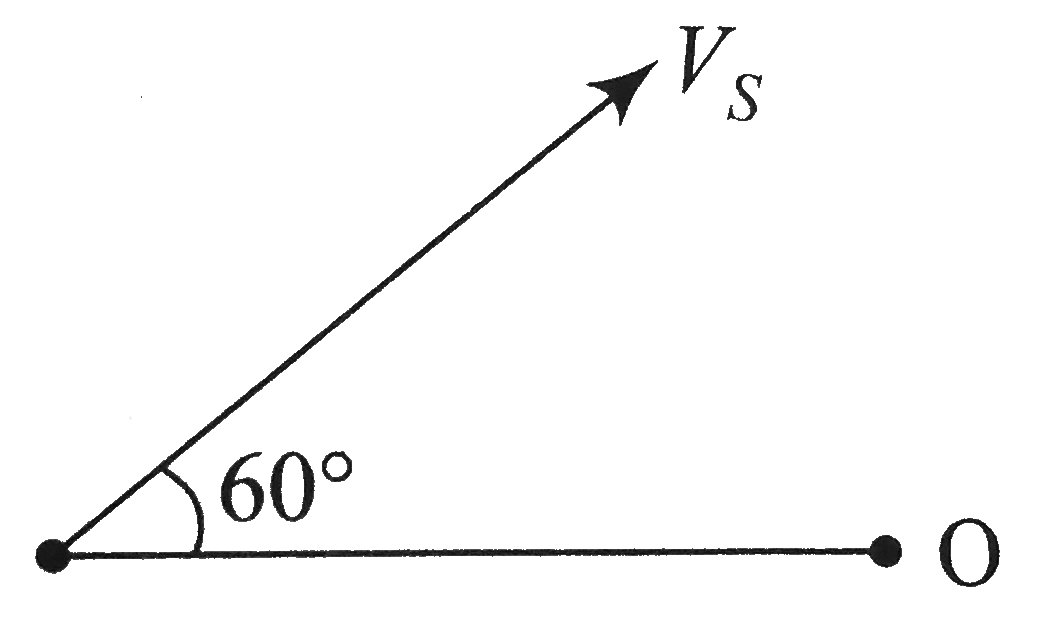A source of sound S emitting waves of frequency 100 Hz and an observer 0 are located at some distance from each other. The source is moving with a speed of 19.4ms−1 at an angle of 60∘ with the source observer line as shown in the figure. The observer is at rest. The apparent frequency observed by the observer (velocity of sound in air 330 ms−1) is ......Solution in Gujrati
97 Hz
100 Hz
103 Hz
106 Hz
The correct Answer is:C

We have, fLv+v=fSv+vS
∴fL330+0=100330−9.7
∴fL=330×100320.3=103.03Hz
Topper's Solved these Questions
- BOOK - KUMAR PRAKASHANCHAPTER - WAVESEXERCISE - SECTION-F (Questions From Module) (Sample questions for preparation of competitive exams)23videos
WAVES
- BOOK - KUMAR PRAKASHANCHAPTER - WAVESEXERCISE - SECTION-D (NCERT Exemplar Solution) (Long Answer Type Questions)5videos
WAVES
- BOOK - KUMAR PRAKASHANCHAPTER - UNITS AND MEASUREMENTEXERCISE - Section -F (Questions from Module )20videos
UNITS AND MEASUREMENT
- BOOK - KUMAR PRAKASHANCHAPTER - WORK, ENERGY AND POWER EXERCISE - QUESTION PAPER (SECTION - D)1videos
WORK, ENERGY AND POWER
Similar Questions
In a standing wave formed by two atoms separated by 1.21Å, there are 3 nodes and 2 antinodes. Find its wavelength.
05:37View SolutionThe earth has a radius of 6400 km. The inner core of 1000 km radius is solid. Outside it, there is a region from 1000 km to a radius of 3500 km which is in molten state. Then again from 3500 km to 6400 km the earth is solid. Only longitudinal (P) waves can travel inside a liquid. Assume that the P wave has a speed of 8 kms−1 in solid parts and of 5kms−1 in liquid parts of the earth. An earthquake occurs at some place close to the surface of the earth. Calculate the time after which it will be recorded in a seismometer at a diametrically opposite point on the earth if wave travels along diameter ?
02:21View SolutionIf the error in measurement of radius of a shpere is 2% then the error in determination of volume of the sphere will be …………
01:32View SolutionA 1 kg block situated on a rough incline is connected to a spring constant 100Nm−1 as shown in figure . The block is released from rest with the spring in the unstretched position . The block moves 10 cm down the incline before coming to rest . Find the coefficient of friction between the block and the incline .Assume that the spring has a negligible mass and the pulley is frictionless.
 04:26View Solution
04:26View SolutionA source of sound S emitting waves of frequency 100 Hz and an observer O are located at some distance from each other. The source is moving with a speed of 19.4ms^-1 at an angle of 60^(@) with the source observer line as shown in the figure. The observer is at rest. The apparent frequency observed by the observer (velocity of sound in air 330ms^-1 ) is
04:08View SolutionA source of sound emitting a note of frequency 200 Hz moves towards an observer with a velocity v equal to the velocity of sound. If the observer also moves away from the source with the same velocity v, the apparent frequency heard by the observer is
03:49View SolutionA source of sound of frequency 500 Hz is moving towards an observer with velocity 30 m/s . The speed of sound is 330 m/s . the frequency heard by the observer will be
02:22View SolutionA source producing sound of frequency 170 Hz is approaching a stationary observer with a velocity 17 ms^(-1) . The apparent change in the wavelength of sound heard by the observer is (speed of sound in air = 340 ms^(-1) )
07:05View SolutionA source of sound is moving away from an observer at rest with a velocity of 50 m s^(-1) . If the frequency of sound is 200 Hz , find the apparent frequency observed by the observer. (Take velocity of sound = 300 m s^(-1))
04:02View Solution100 हर्ट्ज आवृत्ति ध्वनि उत्पन्न करता हुआ एकध्वनि स्रोत्र S तथा एक प्रेक्षक O एक - दूसरे से कुछ दूरी पर स्थित है। ध्वनि स्रोत्र 19.4 मी /से की चाल से चल से रहा है। उसके चलने की दिशा स्रोत्र तथा प्रेक्षक की स्थितियों को मिलाने वाली रेखा से 60∘ का कोण बनाती है यदि प्रेक्षक अपनी स्थिति पर ही रुका रहता है तो प्रेक्षक द्वारा सुनी हुई ध्वनि की आभासी आवृत्त होगी - (हवा में ध्वनि का वेग 330 मी/से है )
02:58View SolutionA source of sound emitting sound with frequency 540Hz approaches a staionary observer with a speed of 30 ms^-1 . If velocity of sound is taken as 330 ms^-1 , the frequency as heard by the observer will be
03:24View SolutionA sound source emitting sound of frequency 450 Hz is approaching a stationary observer with velocity 30 ms^(-1) and another identical source is going away from the observer with the same velocity. If the velocity of sound is 330 ms^(-1) , then the difference of frequencies heard by observer is
View Solutionएक ध्वनि 30ms−1 की चाल से प्रेक्षक की और गतिमान है तथा प्रेक्षक 60ms−1 की चाल से स्त्रोत की और गतिमान है। तब वायु में ध्वनि की आवृत्ति में मित्रात्मक परिवर्तन है (ध्वनि का वायु में वेग 330ms−1)
View Solution500 हर्ट्ज की आवृत्ति वाला एक ध्वनि का स्रोत एक प्रेक्षक की तरफ 30 मीटर/सेकण्ड के वेग से जा रहा है। ध्वनि की चाल 330 मीटर/सेकण्ड है। प्रेक्षक द्वारा सुनी हुई आवृत्ति होगी
02:32View Solution
A source of sound S emitting waves of frequency 100Hz and an observer O are located at some distance from each other. The source is moving with a speed of 19.4ms−1 at an angle of 60∘ with the source observer line as shown in the figure. The observer is at rest. The apparent frequency observed by the observer (velocity of sound in air 330ms−1) is01:02View Solution

